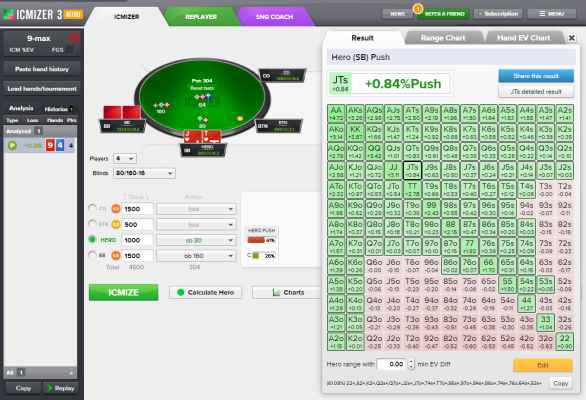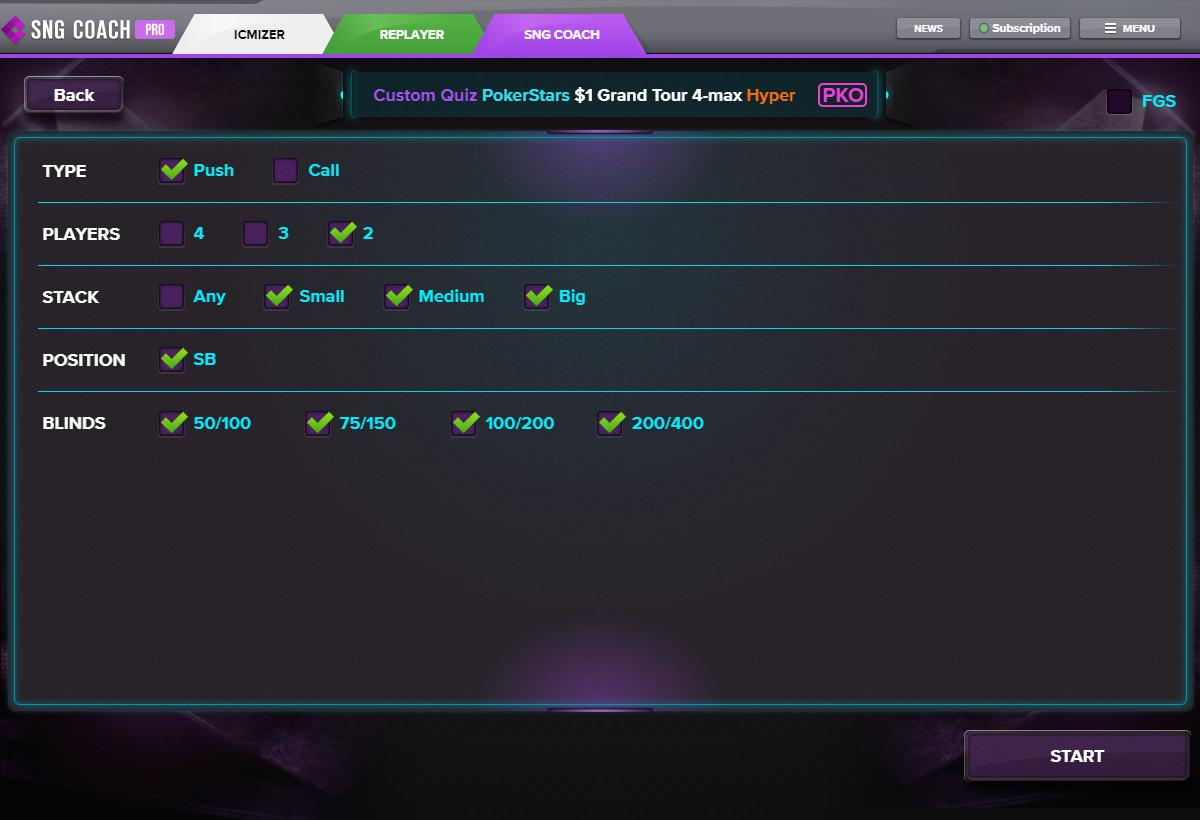Dec 07, 2015 I knew ICMizer was the go-to final table push-fold authority, so I downloaded the program and saw that the player in question should call or fold based almost entirely on the payout structure. Since the WSOP had effectively no payout jumps from 9th to 6th place, the player should call. If the tournament had “standard” payout jumps, he. ICMizer vs Holdemresources Calculator I've been signing both in past month (I don't usually played SNGs or MTTs) and I am considering signing just one of them, not for money reasons ($10 each/month) but because it takes a lot of time to go checking in both similar situations and how each one can be properly used and which situations.
We already spoke about the usefulness of softwares that collect statistical data and info about your opponents at the online poker tables. If you are a serious online poker player, you just have to use one of those products, like Holdem Manager 2, HUD or similar.
But what about the softwares that let you evaluate your decisions as a player? Are they worth the money? The answer is yes, but ... Let's look at what those tools can do and what they cannot do.
All of the above tools are primarily being used to evaluat specific situations outside the actual sessions, but they can also be used during the game, provided you have enough time. In a live game of course they are not allowed, since the use of tablets, smartphones or laptops is always forbidden.
You can input any poker hand before or after the flop and calculate how much your own equity is - for example, to calculate what your percentage is with JTS against AKo. These are the basics, but it gets much more interesting when you define 'Ranges' by either selecting an area like 'the top 25% of all hands' and then seeing which hands are included in this range and how your own hand plays against his range, or you could manually add specific hands and do the same.
Furthermore, you can import hand histories and calculate your own chances in a hand that has already been played, in order to find out whether you have played optimally. This is a lot of work, but it helps to find leaks in your own game.
In practice, these tools can be a great help. Let us assume you have a player with a large number of statistics, e.g. according to Holdem Manager 2, the player often raises first-in - let's assume 25% of all hands. Flopzilla will tell you that a 25% first-in raise rate means that he raises all Pocket Pairs, all suited connectors from 56s upwards, A4s and better, A9o and better. K9s, Q9s as well as all Broadway Hands.
Now you can assess your own hand and see how often you win against this range. In theory it would be correct to 3-bet if your hand has more than 50% equity against this hand range - mainly because you have additional fold equity (ie the possibility exists for the opponent fold preflop against my 3-bet, and because as the 3-Bettor you will often win the pot after the flop by c-betting.
Icmizer Nitro
So far, so good - but what about the shortcomings of those tools?
Well, first of all, these tools work better for cashgames. In a tournament there are other considerations, namely, your survival in the tournament, or the question of how much of your stack you should risk. In a cashgame, you can always reload, and mathematically correct play is important, because your opponent would otherwise be able to detect weaknesses and exploit them again and again (exploitative play).
In a tournament, the preservation of your own stack is important, especially before the bubble and if you are already in the money and pay rises make survival lucrative. Getting yourself into 55/45% situations for all your chips over and over again inevitably leads to the loss of all your chips.
A further big problem is when, for example, ICMIZER is used to its full potential - this may sound counter-intuitive, but let me show you why:
Let's assume my opponent still has 10 BB, is in middle position, the hand is unraised and he goes all-in. Everyone folds and I have K9s on the big blind, with a stack of 20 big blinds. With ICMIZER I could now calculate with which hands my opponent should go all-in and make a profit 'in theory', then put my hand against it and I would find that a call would be mathematically correct, as my call would win me XXX chips on average.
Here, however, a powerful software such as ICMIZER reaches its limits, because:
- Can I really assume that the opponent actually goes all-in with the theoretically correct range calculated by ICMIZER? Maybe the guy has no idea about ICMIZER or push/fold charts? If his all-in range is significantly tighter, then this ICMIZER calculation is totally useless to me. I can still calculate my hand against the tighter range, but I cannot have the software pick my opponents range for me!
- What happens when I lose the hand? I would go from 20 BB to 10 BB. With 20 BB, I have much more options available in the tournament (for example a preflop raise with a subsequent C-Bet), while with only 10 BB I am almost always left with one decision - all-in or fold. That means that my stack size before and after the hand is important too. If the all-in were for 10 BB while I have a 50 BB stack, a call with 60% equity would certainly be correct.
Conclusion:
These softwares are are excellent tools for training and analysis purposes (especially Flopzilla and ICMIZER), but for the actual decision, you must always include other aspects when making a decision. Especially in a tournament it would be a serious mistake to rely on the recommendations of such tools only!
CHANGELIST
v2.0.0 (up since 12/07/2019)
- First beta of FlopzillaPro!
v1.8.6 (up since 10/05/2019)
- Changes and bugfixes

v1.8.5 (up since 22/11/2017)
- Changes and bugfixes
v1.8.4.1 (up since 13/8/2017)
- Bugfix in HoldEq
v1.8.4 (up since 15/6/2017)
- Changes and bugfixes
v1.8.3 (up since 31/5/2016)
- Changes and bugfixes

v1.8.2 (up since 20/12/2015)
- Some smallish bugfixes
v1.8.1 BETA (up since 29/11/2015)
- Sub-categories can now be added in predef menu (more)
- New edit mode for moving large numbers of ranges (more)
- Some other changes
v1.8.0 (up since 29/11/2015)
- Added equity matrix to HoldEq
- Bugfix
v1.7.9 (up since 5/10/2015)
- Flopzilla no longer works if PokerStars.exe is present
v1.7.8 BETA (up since 26/7/2015)
- HoldEq can now also be started from Flopzilla
- Predef menu can be resized
- Small changes and bugfixes
v1.7.6 (up since 11/7/2015)
- General performance improvement
- HoldEq now also available within Flopzilla directory
- Ctrl+Alt+T now also includes option to show weights
- Alt+W removes custom filters for current board
- Small changes and bugfixes
v1.7.5 (up since 9/4/2015)
- Bugfix
v1.7.4 (up since 7/4/2015)
- Bugfix for importing savefiles
- New update for AlternateReg.exe
- Some graphics changes
v1.7.3 (up since 25/2/2015)
- Added ability to set last board card for equity calcs
- New functionality for AlternateReg.exe
- Weight always 100% if no weight selected
- Bugfixes and changes
v1.7.2 (up since 3/2/2015)
- When connected to HoldEq and exporting to equity graph, mouse over a stat in Flopzilla to see the hands in that stat in the graph (pic)
- Ability to import suited strings (like AhKh,AhQh,AhJh,...)
- Screen can now be magnified (Settings->Magnify screen)
- Number of weight buttons increased to 5
- Pressing 0-5 now (de)selects weight 1 through 5
- Option to hide equity for equity training (right-click the equity field)
- Bugfixes and changes

v1.7.1 (up since 12/12/2014)
- Bugfix in invert feature
v1.7.0 (up since 10/12/2014)
- Some new features for HoldEq
- Instructional video for HoldEq+Flopzilla
- Can now import/export suit settings from/to CardRunnersEV
- Added 'invert' button (next to absolute/cumulative button)
- Number of lines in predef menu now dynamic
- Option to restore hand from last instance
- Option to restore predefs from list of backup files
- Option to restore savefile from list of backup files
- Ctrl+X now stores quicksave. Quick-load with Alt+X (X is 0-9)
- Changes in communication protocol with HoldEq
- Changes in save protocol for storing predefs
- Changes in drawing graphics for slow systems
- Bugfixes and changes
v1.6.9 (up since 30/9/2014)
- Changes in 'register' menu to account for new key system
- Bugfixes and small changes
v1.6.8 (up since 25/6/2014)
- Predefs now also contain suit settings
- Weights now also included in text import/export of range
- Suits now also included in text export of range
- Last loaded range is highlighted for 30 seconds
- If range is selected when storing range, that range is overwritten
- Small bugfixes and changes
v1.6.7 (up since 2/4/2014)
- 'Hotness' now also imported from HoldEq
- Color now also stored in predefined range export
- Mouse scroll now has resolution of 1%
- Mouse scroll can now select 33.3% and 66.7%
- Overlap matrix now also shows weights
- 'Clear all fields' now also clears weights for statistics
- Small bugfixes and changes
v1.6.6 (up since 28/2/2014)
- Added capability to connect to HoldEq
- Added key generator for HoldEq
v1.6.5 (up since 2/10/2013)
- Small bugfixes and changes
v1.6.3 (up since 31/8/2013)
- Small bugfixes and changes
v1.6.2 (up since 13/7/2013)
- Small bugfix
v1.6.1 (up since 12/7/2013)
- Flopzilla will now always run as admin
- Option to import/export predefined ranges (under Save/load)
- New dragable scroll bar for predefs.
- Preflop calcs now roughly 7 times faster
- Preflop calcs now done automatically
- 'Best hand' tracked for preflop stats
- New undo system (Ctrl+Z and Ctrl+R)
- Option to store window size (under Settings)
- Some minor changes+fixes
v1.6.0 (up since 1/7/2013)
- Beta release
v1.5.9 (up since 1/1/2013)
- Boundaries of matrix light up in yellow when hovering
- Added suit restriction to slider's combo counter
- Added 'random' button for dead cards
- Other minor fixes and changes to software
- Added preflop suit selection (below starting hand matrix)
- Added 'Clear all fields button'
- Added optional vertical scrollbar to Flopzilla
- Several improvements to the graphics
Icmizer Fgs
